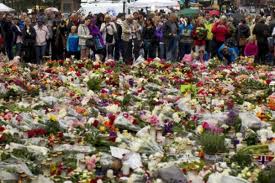by Gordon Lynch
Part of the shock of recent events in Norway is the contrast between the atrocity of the killings with the civilized, civic life of Oslo, and the beauty and peace of Utoya. The violence creates a rupture between the old, familiar meanings of these places, and the meanings they have today as places touched by evil and destruction.
One of the inevitable processes following Friday’s mass killings is a redrawing of the symbolic and moral maps through which people there experience the world. The human experience of space is never simply that of SatNav technology, of space as something to be physically traversed as efficiently as possible. We also experience space in terms of its symbolic significance and the meanings that it has for shared cultural memory.
When such a radical disruption occurs, new maps have to be drawn in which space can be reclaimed for the moral centre of society. This can never be an over-night process, but is the patient work of collective acts of silently occupying public spaces, lighting candles, leaving flowers, and, in time, constructing public memorials. By re-experiencing space in this way, its meaning is redrawn, and through painful and emotional acts of commemoration, the moral centre of society can be re-asserted against the violence that has been unleashed against it. It is hard to watch scenes of silent vigils and torchlight processions in Norway without being moved. But despite their emotional resonance for audiences across the world, the more profound cultural labour is for Norwegians themselves as they rework the meaning that these physical spaces have for them.
One of the things that is striking about this process in Norway is how important religious buildings have been. Like some other Nordic countries, Norway combines high levels of formal church membership with very low rates of church attendance, with younger generations becoming progressively less religious. Despite its small population, Norway also has one of the largest national humanist associations in the world, with thousands of teenagers taking a humanist version of a confirmation class each year. Despite this evident secularity, religious buildings have played an important role in the moral reclamation of space in Norway, as people who might rarely or never attend church come to places such as the Lutheran cathedral in Oslo to sit, reflect or pray. Although religious doctrine and affiliation may have little hold over people’s lives, religious spaces continue to have a profound role as sites where the moral centre of society can be collectively experienced and renewed.
Part of the process of redrawing symbolic maps in the wake of such an atrocity involves not just places, but marking people in terms of their location to moral society. Symbolic boundaries are being renewed through the public exclusion of Anders Behring Breivik. He has become, in some of the language of the media, a demon or devil, something no longer recognisable within the borders of human society. In this context, the labelling of Breivik as a ‘madman’ is not meant to be a clinical diagnosis (as some media outlets have implied), but becomes a way of placing someone on the moral map of society. Just as rationality has become one of the defining features of what it means to be a proper member of society, to be designated a ‘madman’ is one more way in which we can symbolically place someone beyond the terrain of moral society.
These boundaries are not permanently fixed, but are always subject to being drawn and redrawn as society experiences new expressions of profanity. As Breivik becomes the evil against which society defines itself, so right-wing, anti-immigration parties which have had some success recently in Nordic politics may find the moral landscape increasingly defined against them. These boundaries are not always innocent, either. Those who are morally excluded can find themselves treated as less than human, as detainees of Guantanamo Bay found to their cost. What is inspiring about the response to Breivik’s murders, though, is the evident will to renew the sacred centre of Norweigian public life in a way that honours its best civic and democratic aspirations. In this way, as they deal with the terrible aftermath of these events, the people of Norway have much to teach us about what it means to be human.
Gordon Lynch is Michael Ramsey professor of modern theology at the University of Kent. His work focuses on the cultural sociology of the sacred, and the relationships between religion, media and contemporary culture. His next book, The Sacred in the Modern World: A Cultural Sociological Approach is due to be published by Oxford University Press in spring 2012.



